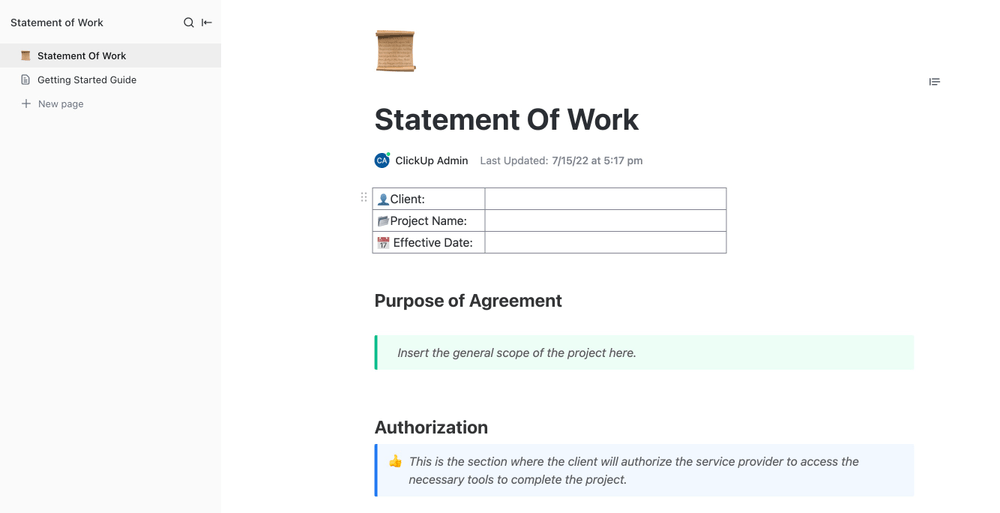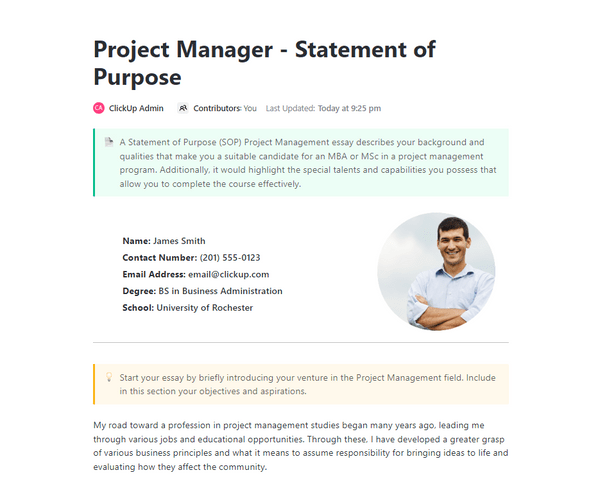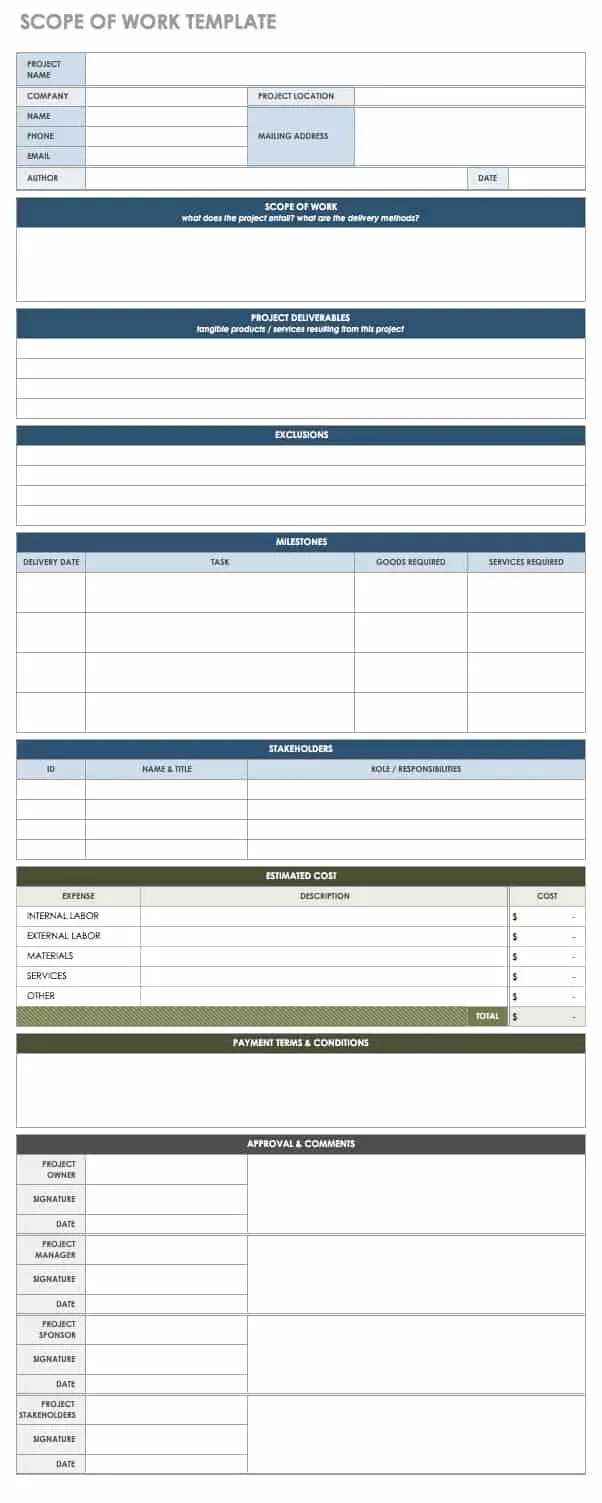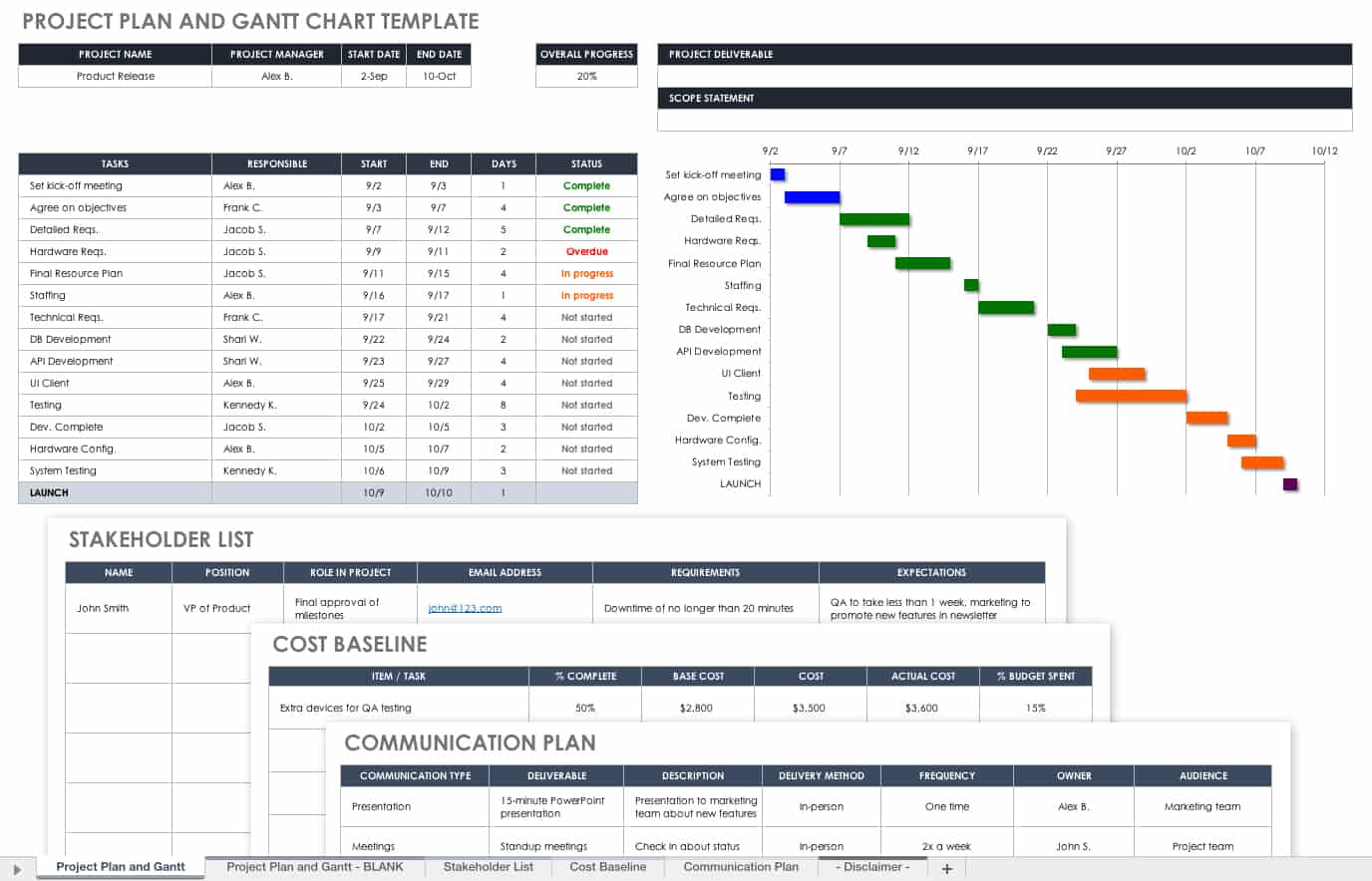
Optimize Project Management with Statement of Work Template

Project planning is critical in ensuring successful project execution and achieving desired results. A vital tool in this process is the creation of a complete Statement of Work (SOW).
The SOW is a guiding document that outlines the entire project, from its inception to completion. It involves defining project goals, documenting key expectations, and setting the boundaries within which the project will operate. By incorporating project documents, such as the project charter template and master services agreement, the SOW provides a clear roadmap for project leaders, stakeholders, and teams to follow.
In this article, we will explore the significance of project planning, delve into the critical elements of an effective SOW, and discuss strategies to create a robust SOW that drives project success. We will highlight the importance of clear objectives, documenting expectations, and mitigating risks to ensure project alignment and smooth execution. Whether you are a project manager, team member, or stakeholder, understanding how to craft and utilize a well-defined SOW can be a game-changer in achieving project goals, helping during the project phase and also giving post-project support, delivering high-quality results, and maximizing organizational success.
What is a Statement of Work?
A Statement of Work (SOW) serves as a vital document that defines a project's scope, objectives, and deliverables. It provides a detailed overview of the work, acting as a roadmap for project managers, stakeholders, and team members.
The SOW is a formal agreement between the client and the service provider, outlining the project’s key details and expectations. It serves as a reference point for project management and establishes a common understanding of the project’s requirements, timelines, and milestones.

Why is a Statement of Work Important?
A Statement of Work (SOW) holds significant importance in project management for several key reasons. Let’s explore why creating a comprehensive SOW is crucial for project success:
Clearly Defines Project Scope
The Statement of Work provides a clear and concise definition of the project’s scope and objectives. It outlines the boundaries, project deliverables, and tasks to be accomplished, ensuring that all stakeholders understand what will be achieved.
Mitigates Scope Creep
By explicitly documenting the project’s scope and deliverables, the SOW helps prevent scope creep. It acts as a reference point that allows project managers to control deviations or requests for additional work that fall outside the defined scope, thereby ensuring project focus and preventing unnecessary changes.
Serves as a Binding Contract
The SOW acts as a contractual agreement between the client and the service provider. It provides a legal framework that protects the interests of both parties, establishing the terms and conditions under which the project will be executed. This binding document provides a basis for resolving disputes or conflicts that may arise during the project lifecycle.
Guides Project Management Efforts
The SOW serves as a roadmap for project managers and team members, providing a structured outline of the tasks and responsibilities involved. It acts as a guide to track progress, monitor timelines, allocate resources, and ensure that project objectives are met effectively.
Enhances Communication and Collaboration
The Statement of Work fosters effective communication and collaboration among project stakeholders. It ensures that all parties involved, including the client, project manager, and team members, are on the same page regarding project requirements, milestones, and deliverables. This alignment minimizes misunderstandings, promotes transparency, and strengthens working relationships.
Facilitates Project Evaluation
A well-crafted Statement of Work provides a benchmark against which project performance can be evaluated. It enables project managers and clients to assess the progress and success of the project, comparing actual outcomes against the defined deliverables and objectives. This evaluation helps identify areas for improvement, learning, and future agreements.
Timeline and Milestones
The Statement of Work includes a timeline that outlines the project’s phases, milestones, and expected completion dates. This timeline helps set realistic expectations, manage deadlines, and monitor project progress.
Responsibilities and Resources
The Statement of Work assigns specific responsibilities to the project team members or departments involved. It outlines each party's roles, tasks, and responsibilities and clarifies the resources required to complete the project successfully. This section ensures that everyone understands their contributions and fosters effective collaboration.
Project Budget and Payment Terms
The Statement of Work often includes information regarding the project’s budget, cost estimates, and payment terms. It outlines the financial aspects of the project, including payment milestones, invoicing procedures, and any additional expenses or reimbursements.
Acceptance Criteria and Quality Control
The Statement of Work may outline the acceptance criteria for deliverables and the quality control measures to be implemented. This ensures the project meets the client’s expectations and maintains a high-quality standard.
In summary, a Statement of Work is vital to ensure project clarity, establish expectations, and serve as a foundation for successful project management. It minimizes risks, facilitates effective communication, and sets the stage for a collaborative and well-executed project. Project stakeholders can lay the groundwork for a successful and mutually beneficial project outcome by investing time and effort into creating a comprehensive SOW.
What Should a Statement of Work Include?
A well-crafted Statement of Work encompasses several key components for effectively defining and managing a project. When creating a comprehensive SOW, include the following elements:
Project Overview
Begin the Statement of Work with an introduction that provides a high-level summary of the project. Include a brief description of the project’s purpose, objectives, and the parties involved. This section sets the context for the entire document.
Scope of Work
Clearly define the project’s scope by detailing the specific tasks, activities, and deliverables that will be completed. Specify what is included in the project and, equally important, what is not included. This section helps manage expectations and prevents scope creep.
Project Deliverables
Outline the tangible outputs or outcomes that will be produced as a result of the project. Clearly describe each deliverable, providing a detailed explanation of what is expected. This section allows both the client and the service provider to have a shared understanding of the desired end products.
Project Timeline
Include a timeline that outlines the project’s phases, milestones, and estimated duration for each activity. Specify the start and end dates for the project, as well as any key dates or deadlines. This timeline is a reference for project scheduling and helps all stakeholders track progress.
Project Team and Responsibilities
Identify the project team members and their roles and responsibilities. Clearly define the responsibilities of each team member and specify their involvement in the project. This section ensures accountability and clarity regarding who is responsible for specific tasks.
Project Deliverable Acceptance Criteria
Specify the criteria that will be used to determine the acceptance of each deliverable. Outline the quality standards, performance expectations, and any specific metrics that will be used to assess the deliverables. This section ensures that the client’s expectations are met and provides a basis for evaluation.
Project Communication Plan
Define the communication channels and protocols that will be used throughout the project. Specify the frequency and methods of communication, such as meetings, reports, or email updates. This section promotes effective communication among project stakeholders and ensures everyone remains informed.
Project Budget and Payment Terms
Include details about the project budget, cost estimates, and payment terms. Specify the payment milestones, invoicing procedures, and any additional expenses or reimbursements. This section helps manage financial aspects and ensures transparency in terms of project costs.
Project Risks and Mitigation Strategies
Identify potential risks and challenges that may impact the project’s success. Describe the strategies and measures that will be implemented to mitigate these risks. This section demonstrates proactive risk management and helps minimize potential project setbacks.
Project Change Management
Outline the process and procedures for managing changes to the project scope, schedule, or budget. Specify how change requests will be evaluated, approved, and implemented. This section ensures that changes are properly assessed and controlled to avoid disruptions.
Remember, while these components form the foundation of a comprehensive SOW, it is important to customize and adapt them to each project's specific needs and requirements. By including these essential elements, you can create a robust SOW that sets the stage for successful project execution and clear stakeholder expectations.
Writing a Statement of Work
Crafting a well-structured and comprehensive Statement of Work (SOW) is crucial for effective project management. Here are some valuable tips and strategies to guide you through creating a strong SOW:
Understand the Project Requirements
Start by thoroughly understanding the project requirements, objectives, and desired outcomes. Consult with the project initiator and key stakeholders to gather all the necessary information and clearly understand their expectations.
Define the Scope and Deliverables
Clearly define the scope of work by outlining the specific tasks, activities, and deliverables that will be included in the project. Break down the project into manageable components and describe each deliverable in detail. This helps avoid ambiguity and ensures alignment among all parties involved.
Use Clear and Concise Language
Write the Statement of Work in clear, concise, and easily understandable language. Avoid technical jargon or industry-specific terms that may confuse readers. Use plain language to communicate the project details and requirements.
Include Measurable Objectives
Specify measurable objectives and outcomes for the project. This allows for effective evaluation and assessment of the project's success. Use specific metrics or performance indicators to measure progress and determine if objectives have been achieved.
Define Project Timelines and Milestones
Establish a realistic timeline for the project, including start and end dates and key milestones or phases. Break down the project into manageable timeframes to ensure progress can be tracked and deadlines are met. Be mindful of any dependencies or interdependencies between tasks.
Assign Roles and Responsibilities
Clearly outline the roles and responsibilities of each team member or department involved in the project. Specify who will be responsible for specific tasks, deliverables, and decision-making. This promotes accountability and ensures that everyone understands their contributions to the project.
Set Expectations for Quality and Acceptance Criteria
Clearly define project deliverables' quality standards and acceptance criteria. Specify the criteria that will be used to determine whether the deliverables meet the required standards. This helps manage expectations and ensures that the client’s requirements are met.
Identify and Mitigate Risks
Identify potential risks and challenges that may impact the project’s success. Document these risks and develop strategies to mitigate them. Address how risks will be monitored, assessed, and managed throughout the project lifecycle.
Incorporate a Change Management Process
Include a straightforward process for managing project scope, schedule, or budget changes. Outline how change requests will be evaluated, approved, and implemented. This ensures that changes are properly assessed and controlled to minimize disruptions.
Review and Seek Feedback
Before finalizing the Statement of Work, thoroughly review and seek feedback from key stakeholders. Ensure that all project requirements and expectations are accurately captured. Incorporate any necessary revisions or clarifications based on the feedback received.
Use Templates and Industry Standards
Consider utilizing the Statement of Work templates that we are providing in this article, and also the industry best practices to streamline the process and ensure completeness. The templates provide a structured framework and help ensure all necessary components are included in the Statement of Work.
Seek Legal Review if Applicable
In complex projects or when dealing with legally binding agreements, seeking legal review of the Statement of Work is advisable to ensure compliance and protection of all parties involved.
Following these tips and strategies, you can create a comprehensive and effective Statement of Work that sets clear expectations, mitigates risks, and fosters successful project management. Remember to tailor the SOW to the specific needs of each project and maintain open communication with stakeholders throughout the process.
Statement of Work Templates
There is a collection of helpful templates that can assist you in creating a robust Statement of Work for your projects. These templates are designed to save time and effort by providing a structured framework and guidance for writing an effective SOW. Please note that the templates require Microsoft Office (Microsoft Word and Excel) to access and utilize them. If you don’t have Microsoft Office, you can obtain a product key from RoyalCDKeys, which offers reliable and affordable software solutions.
With these templates and the necessary software, you can create a comprehensive SOW that sets clear expectations and ensures successful project management.
Statement of Work Template

This Statement of Work (SOW) Template directs users to determine their projects' details with customers or suppliers. It proposes clear instructions on what to include in an SOW, such as deliverables, scope of work, landmarks, requirements, and expense terms.
Project Manager Statement of Purpose Template

This Project Manager Statement of Purpose Template helps you create a clear Statement of Purpose in project management. It guides you to effectively showcase your knowledge, aptitudes, and experiences in project management, from the introduction of your aspirations in the field to documenting professional experiences.
Project Scope Template

Use this scope of work template as part of a comprehensive statement detailing the job or as a single document, such as an SOW agreement. The template models a straightforward format and provides sections to add data about deliverables, tasks, scheduling, and other project scope details.
Project Plan Template

Once you’ve finished your statement of work, you may want a tool to track your project’s improvement through completion. This project plan template delivers room for basic information, as well as a table where you can list each assignment, the responsible group, and its rate.
Conclusion
A well-crafted and detailed Statement of Work is essential for the successful execution of internal projects and the achievement of desired outcomes. As the project leader, it is crucial to define project boundaries, identify key stakeholders, and clearly articulate expected outcomes in the SOW.
By utilizing free statement templates, project plan templates, and even a simple Microsoft Word statement, project managers can create a comprehensive SOW document that covers important details, such as payment terms, essential information, and due dates.
The SOW not only helps avoid scope creep and security issues but also contributes to the overall success of the project by establishing clear expectations, mitigating conflicts, and facilitating smooth implementation. It outlines the roles and responsibilities of the people involved, creates a task list for reference, and acts as a guide for accomplishing actionable steps.
By leveraging the power of SOW templates, project managers can save time, ensure clarity, and contribute to the organization's overall efficiency and growth, Whether it’s a new project or a recurring one, utilizing a detailed SOW in the appropriate format helps establish a solid foundation, manage resources, and deliver exceptional results.















